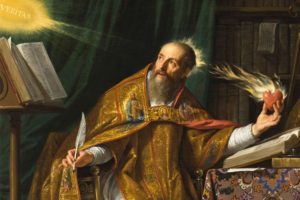Determining whether your community is predominantly Catholic was once fairly simple. You’d see multiple parishes with names like “Saint Petronille” and “Holy Family.” Your local hardware would sell Saint Joseph statues (burying St. Joe upside-down in the yard is thought to help the process of selling a house). You’d notice ashen foreheads during Lent and couldn’t find a can of tuna fish at the supermarket during the same month. Today, however, the signs are not so obvious.
We see this change on display in Kerry Kennedy’s best seller from a few years ago, Being Catholic Now, in which 37 contributors, most of them public figures, speak about the form and substance of their Catholic faith. As I then stated in my review, “Identity Theft,” these accounts showcase the widespread redefinition of contemporary Catholicism in America. Or take note of this summary statement by the Catholic author Peter Feuerherd in his book Holyland USA: A Catholic Ride Through America’s Evangelical Landscape:
In reality, Catholicism includes those with disparate authority and opinions about almost everything under the sun. There are liberal bishops and conservative bishops. The pope sometimes differs with his own Curia. American Catholic voters are regularly viewed by experts as a crucial swing group in every national election, too diffuse to truly categorize. In fact, some scholars of religion refer to Catholicism as the Hinduism of Christianity, because it is infused with so many different schools of prayer, ritual, and perspective, much like the native and diverse religions of India now referred to under the single rubric of Hinduism.
It is easy for us on the outside to conclude that Catholic faith and practice must be unified. We see the outward forms of the tradition: the clerical attire of priests, the common liturgy, and the ecclesial symbols that compose parish life. But this analysis will not suffice. Profound variety lurks inside, whether through particular religious orders (consider the differences between Jesuits and Franciscans) or between liberal and conservative priests. As a former Catholic, I observe three general types of Catholics in America today. Such insight can aid our ministry among Catholic friends.
Traditional (or Traditionalist) Catholics
One expression of contemporary Catholicism tends toward fundamentalism. These “Traditional” Catholics operate with a pre-Vatican II (1962-1965) mindset, eschewing personal dimensions of faith. They often have an adversarial posture toward Protestantism and an aversion to personal Bible study. “My priest tells me what the Bible means,” you’ll often hear them say. Because Traditional Catholics do not recognize Protestants as legitimately Christian, they decline invitations to visit your church and avoid religious conversation directed at them or their family.
Before we are too hard on Traditional Catholics, we must realize that from their perspective they are simply being faithful. Think of it this way: How do you feel when Mormons or Jehovah’s Witnesses visit your little sister, son, or granddaughter with an invitation to visit their kingdom hall? Because evangelicals view such groups as cults outside the pale of Christian orthodoxy, we feel defensive and even less than congenial toward those who attempt to undermine the faith. This is the sort of obstacle we’re dealing with when we talk with a Traditional Catholic.
Charismatic (or “Evangelical”) Catholics
Pope Paul VI (1963-1978) often gets credit for shaping the Charismatic Catholic identity, particularly in his exhortation titled Evangelii nuntiandi. The pontiff’s statement emphasizes the lay-empowered impulse of Vatican II in terms of the evangelistic calling of every Catholic. Paul VI stressed a number of themes familiar to evangelical Protestants, including personal relationship with the living Christ, the indwelling Holy Spirit, and the need to serve the larger community. Thus, Charismatic Catholics demonstrate a vibrant and charismatic experience of faith, concern for biblical teaching, and personal, Jesus-centered devotion. These men and women listen to Protestant radio, receive the Christian Book Distributor catalogue, and regularly enjoy participating in our church’s Bible study and prayer groups.
Cultural (or Nominal) Catholics
When these people enter the hospital or complete a census, they register themselves as “Roman Catholic,” despite the fact that they’ve missed Mass for nine straight years. Or maybe they attend Mass twice a year, on Christmas and Easter (hence the designation “Chreaster”). They are the “cafeteria Catholics” who pick and choose elements of religion to suit their taste, like a vegetarian picking lettuce and onions from the buffet line at Bubba’s Rib Fest. Perhaps they go to church when they need something from God. Just like the nominal Protestant, these Catholics use the religious label even though Christianity has little or no influence upon their lives.
Implications for Gospel Ministry
It is not enough to understand Catholic doctrine; we must also pause to consider assumptions, priorities, attitudes, fears, and common commitments. Like good missionaries who carefully “read” their context, we can (and should) do the same. Specifically, we look for common ground that can support meaningful conversation.
It’s easy to find common ground with the “Evangelical” (or Charismatic). Since we share a similar commitment to the Bible, we might invite this friend to study Scripture or read a devotional book together.
Among Traditional Catholics, I take the posture of a student (genuinely) interested in learning about the religious customs that matter to my friend. Holidays such as Christmas and Easter, Feast Days, and Rites of Passage (e.g., Communion and Confirmation) are classic examples.
For all intents and purposes, the Cultural Catholic is like an agnostic—offering lip service to God’s existence, while resisting his divine authority. With the resources of Christian love and grace, I invest in this relationship, hopefully earning trust and credibility in the process. And when a crisis hits my Cultural Catholic friend (as it does for everyone) I hope to have the privilege of explaining the meaning of the cruciform ornament that hangs around his neck—that on a real cross a certain Savior truly hung, and then rose from the dead, so that men and women, trusting in him, would enjoy a living hope.
In pursuit of our evangelistic calling, Paul exhorts the Colossians to speak with clarity, intentionality, and grace (4:2-6). He envisions a church full of men and women who dedicate attention to verbal witness “so that you may know how you ought to answer each person.” In addition to considering how Scripture conveys this message, we dedicate time to understanding our Catholic community, for this is what fruitful gospel service requires.





